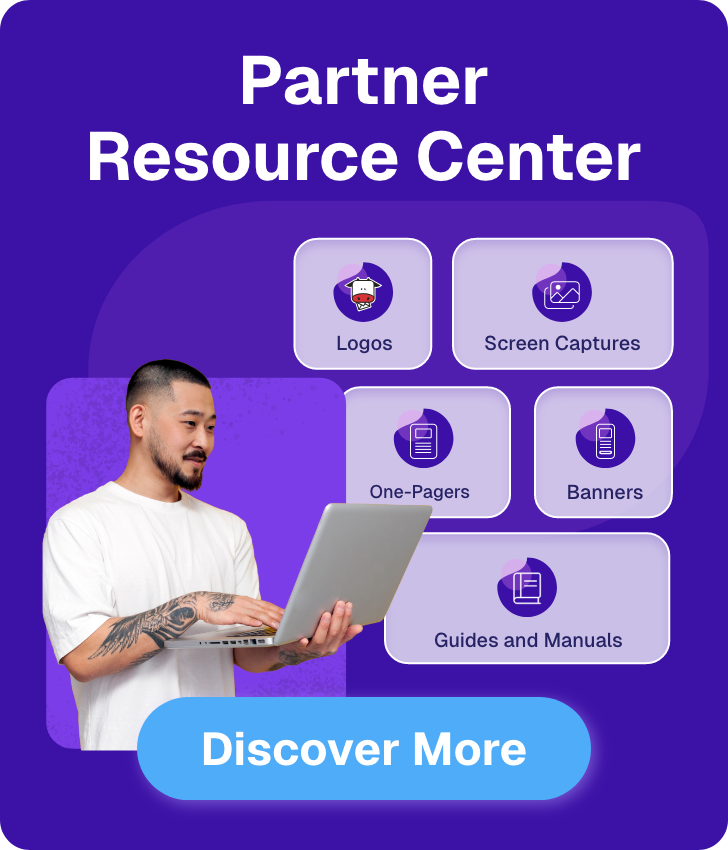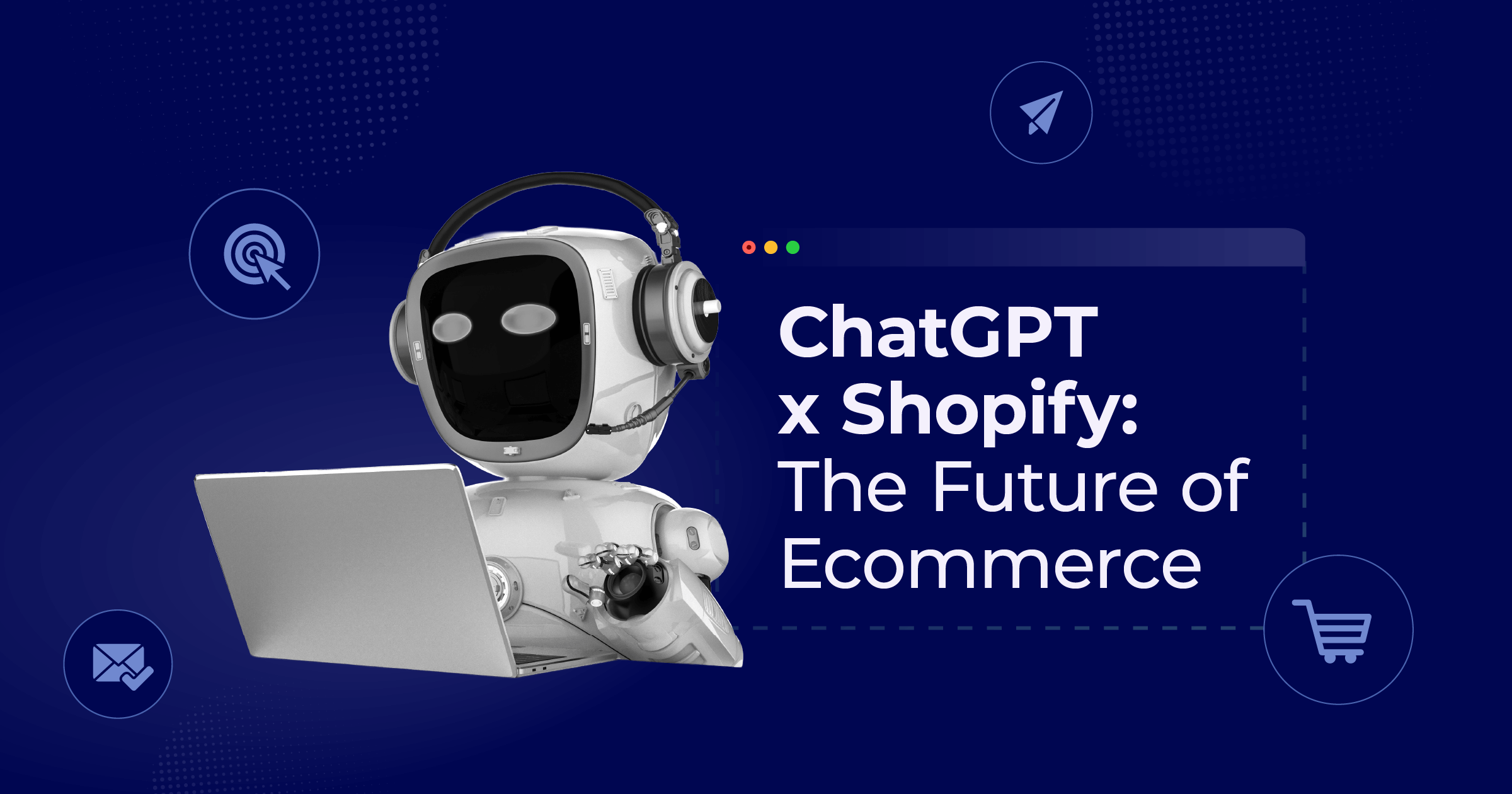
AI in Email Marketing: Game-Changer or Deal-Breaker?
Email has been “declared dead” more times than content has been crowned “king.” Yet somehow, like a friendly zombie, it keeps coming back, very much alive, engaging, and still one of the most profitable channels in digital marketing.
But what about Artificial Intelligence? Well, AI isn’t here to put the final nail in email’s coffin. If anything, it’s handing email new tools and maybe even a makeover. But there’s a twist. Every advantage AI offers can just as easily turn into a weakness.
Today, we’ll explore the changes, opportunities, and risks of AI in email marketing and how to ensure your campaigns remain effective, regardless of the circumstances.
Email ROI: Increasing Revenue and Efficiency
Email’s return-on-investment (ROI) is the stat everyone in marketing loves to quote: $36 for every $1 spent, and in some cases, as high as $50. That’s the reason email has outlived every “email is dead” headline, as it’s simply one of the most cost-effective channels out there.
Now, if you type “AI and email ROI” into Google, you’ll see the same promise repeated endlessly: AI will make these numbers even better. And they’re not wrong.
The ROI opportunity
When used strategically, AI directly improves ROI by lowering costs and maximizing impact. For instance, automating A/B testing and streamlining production reduces the time (and money) spent on manual work.
Predictive send times and optimized subject lines also increase open rates and clicks, driving more revenue per campaign. At the same time, smarter segmentation ensures that messages reach the right people at the right moment, which, of course, translates to more conversions.
The risk of losing revenue
On the other hand, AI can just as easily hurt your ROI if it churns out irrelevant or generic campaigns. This is typically followed by a decline in engagement and an increase in unsubscribes. As a result, the “$36 for $1” math stops adding up.
Let’s take an eCommerce brand that relies on AI to create product recommendation emails. Instead of tailoring offers based on purchase history, the system sends the same generic “Top Picks” message to every subscriber.
Customers ignore it, unsubscribe, or mark it as spam, which not only harms ROI but also deliverability. The cost of sending stays the same, but the revenue per campaign drops.
How to mitigate the risk
To avoid the risk, marketers should combine automation with human oversight.
For instance, use AI to cut costs and increase efficiency, but keep the creative direction, audience insight, and quality control in human hands. That balance is what turns AI into a support system that boosts your email ROI, rather than harming it in the long run.
Email List: Targeting Subscribers with Hyper-Segmentation
One of email’s biggest advantages is having a list of engaged contacts.
Unlike social platforms where algorithms decide who sees your content, your list belongs to you. And because of that, marketers have often gone the extra mile to make emails feel personal, as a loyal audience will lead to better retention and revenue.
Ever received a plain-text campaign that looks like a one-to-one message from the founder? Here’s one from Ugmonk:
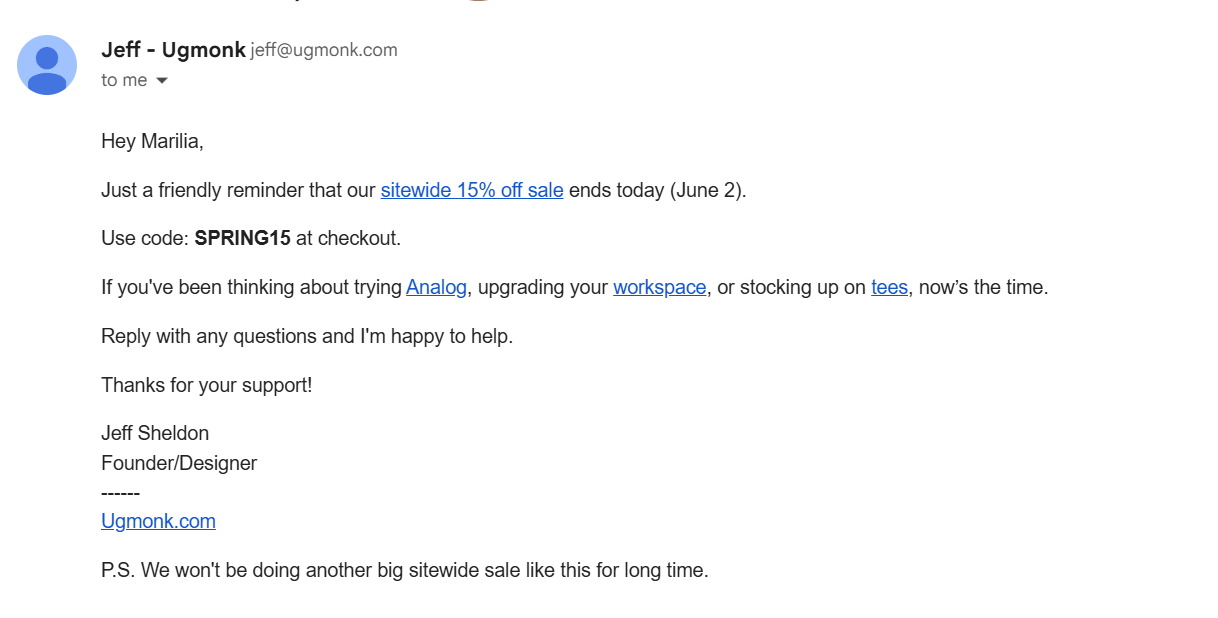
This campaign is short, simple, and written as if Jeff sent it directly to you. That personal feeling is what makes email different from a social feed.
The hyper-segmentation opportunity
AI can make your email list far more powerful by hyper-segmenting subscribers and tailoring messages that truly resonate.
Instead of blasting the same newsletter to everyone, AI can analyze behavior and preferences to support hyper-segmentation, suggesting the right tone, style, or offer for each subscriber group.
Executed well, this turns your list into a dynamic asset, where you can scale personalization and keep your messages meaningful.
The risk of AI hyper-segmentation
Hyper-segmentation may sound powerful, but it can backfire.
Breaking your list into dozens of micro-groups often means sending more messages, using more resources, and overwhelming subscribers with constant “personalized” offers.
Instead of feeling relevant, the inbox starts to feel crowded. Push it further into hyper-personalization, and the risk can increase as emails that track every click, browse, or login detail can come across as intrusive. What should feel like a thoughtful connection quickly turns into overexposure, and the intimacy of email is lost.
How to mitigate the risk
The key is to avoid dividing your list into endless micro-segments or overloading subscribers with constant “personalized” messages.
Instead, let AI handle lower-value, repetitive tasks, such as reminders, re-engagement emails, or transactional updates, where efficiency matters most. For high-value campaigns that build relationships, rely on your team’s creativity and judgment.
This balance keeps personalization meaningful, prevents resource drain, and ensures subscribers feel valued rather than over-targeted.
Email Copywriting: A Cure for Writer’s Block
Writer’s block can be brutal when you’re an email marketer. The newsletter deadline is getting closer, your abandoned cart flow needs a refresh, and the promo campaign is waiting for subject lines that don’t sound recycled.
Staring at a blank screen when you need fresh copy fast is enough to make anyone panic. Fortunately, innovative AI writing tools like ChatGPT and Jasper are here to help.
The opportunity to streamline email copywriting
AI software can help you analyze past campaigns to see which subject line styles resonate most, suggest fresh angles for newsletters, or even generate visual drafts to spark new ideas.
For email marketers who handle weekly sends and automated flows, this means spending less time starting from scratch and more time creating campaigns that connect with subscribers
For example, you could ask Gemini: “Give me 10 subject lines for a Valentine’s Day flash sale on skincare products.” Within seconds, the AI assistant will give you some quick options to consider.
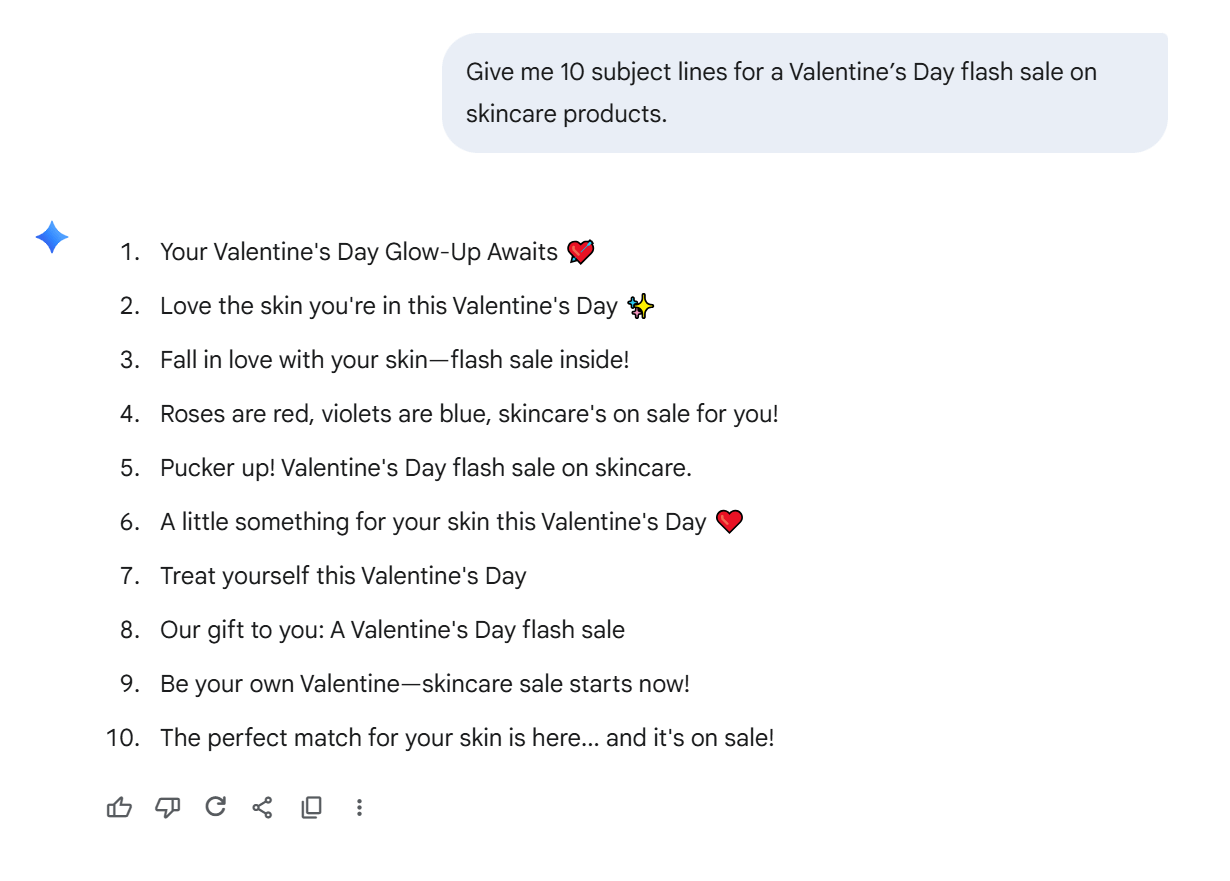
The risk of using AI for email copywriting
AI can clear your writer’s block, but it often creates new challenges. Marketers may spend more time prompting, re-editing, and sorting through repetitive outputs than actually writing.
What feels like a shortcut can quickly lead to AI-generated copy that sounds generic, off-brand, or too similar to competitors using the same tools. Over time, this undermines the originality that makes email effective.
Also, if you continually test every new AI feature and prove its value, what started as a solution for speed can become a source of burnout for email teams.
How to mitigate the risk
AI works best as a creative assistant, not a replacement. Let it handle quick drafts, idea starters, or lower-value messages, and reserve your team’s energy for high-impact email copy that builds relationships and showcases your brand’s voice.
To give you a hand, many ESPs now include built-in AI writers that help reduce the pressure of constant prompting and switching between tools.
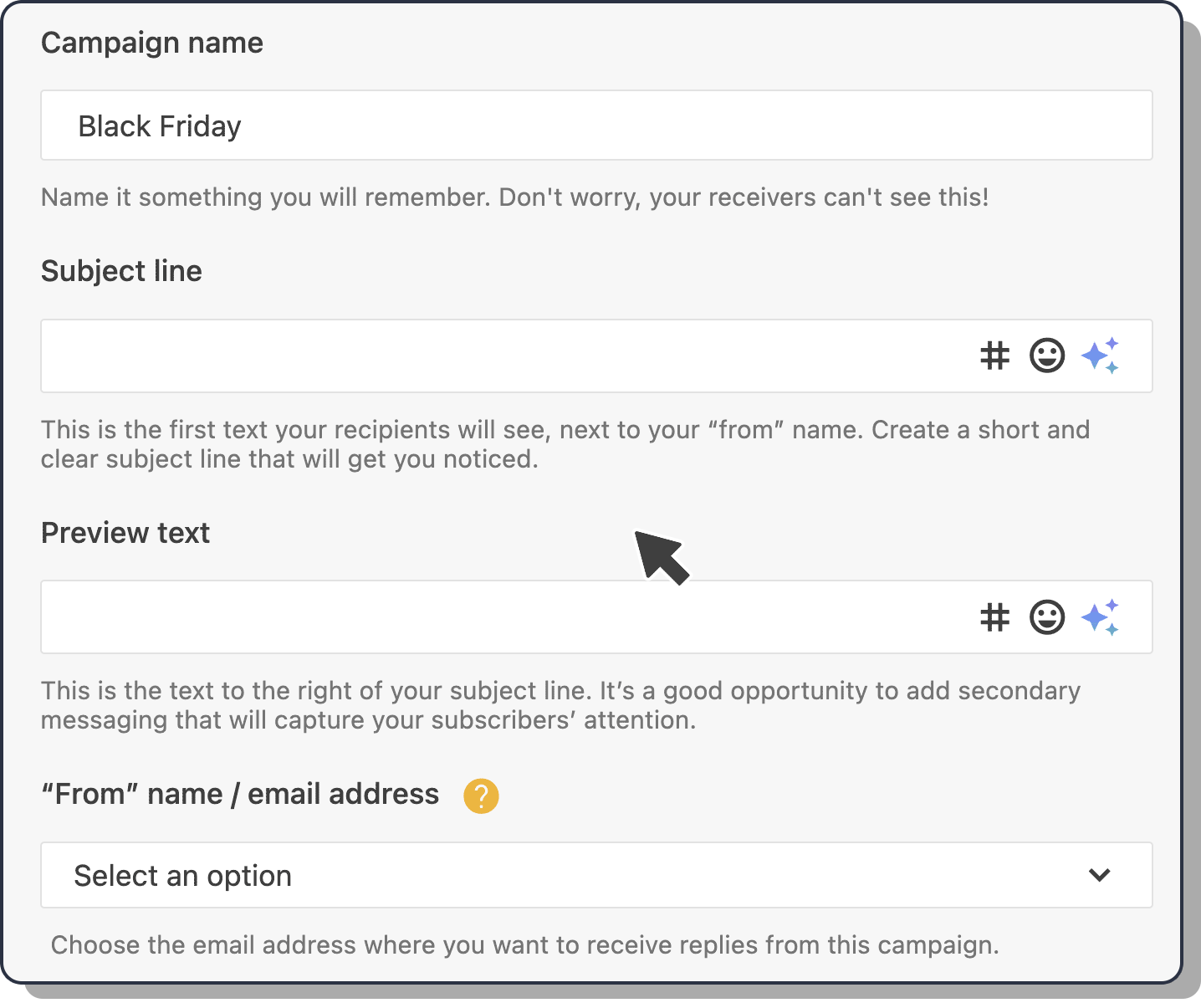
Tools like Moosend’s AI Writer, for instance, can help you generate subject lines or email copy ideas in seconds. Similarly, Constant Contact’s Content Generator extends that support across emails, landing pages, SMS, and even social posts.
By using these integrated features, marketers can streamline repetitive tasks without needing to use multiple apps or be overwhelmed by endless outputs. The key is to let these tools handle efficiency, while your team stays focused on originality and strategy.
This way, you keep campaigns fresh, on-brand, and free from burnout.
Email Deliverability: Increasing Inbox Placement
AI is reshaping how marketers monitor and protect deliverability.
Instead of waiting for problems to show up in reports, AI tools can now scan bounce patterns, detect spam triggers, and track sender reputation in real time. This shift from reactive checks to proactive monitoring provides email teams with earlier warnings and more opportunities to resolve issues before they impact inbox placement.
The opportunity for better deliverability
With AI, marketers can act before problems escalate. For example, if engagement dips in a segment, AI can suggest list cleaning or new targeting rules.
It can also flag subject lines or templates that appear spammy to filters, reducing the risk of campaigns being marked as junk. The result is higher inbox placement and more consistent performance across campaigns.
The risk of ending up in the spam folder
Unfortunately, deliverability is a double-edged sword. Over-automation can encourage marketers to send more and faster without checking quality.
If AI-generated content feels generic, irrelevant, or misleading, subscribers are more likely to ignore it, unsubscribe, or click the spam button. As mentioned earlier, these signals lower the sender’s reputation, which affects inbox placement not just for one campaign but for all future ones.
How to mitigate the risk
To prevent harming your deliverability, use AI as an early warning system, not as a shortcut to volume. Monitor the data it provides closely, but keep humans in charge of content quality and email list hygiene.
Also, combine AI-driven detection with healthy sending practices. That’ll keep your emails landing in the inbox and your subscribers happy.
Email Design: Simplifying Email Template Creation
AI-powered design tools can now generate entire templates, optimize layouts for both mobile and desktop, and even test which visual elements drive the most engagement.
For email marketers, this means less time tinkering with formatting and more time experimenting with creative approaches.
The opportunity of creating more and better templates
When used effectively, AI can enhance email design. It can adapt a template automatically for different devices, suggest color palettes that improve readability, or even generate quick visual drafts for seasonal campaigns.
Smaller teams can utilize AI design tools to create polished, professional emails at scale, eliminating the need for additional resources or support.
The risk of AI-generated email design
Low-quality AI-generated images are easily identifiable, as they often appear generic, awkward, or even fake. Instead of impressing, they create distrust and signal that the brand is cutting corners.
Here’s an AI-generated email template from OpenAI’s DALL·E 3.
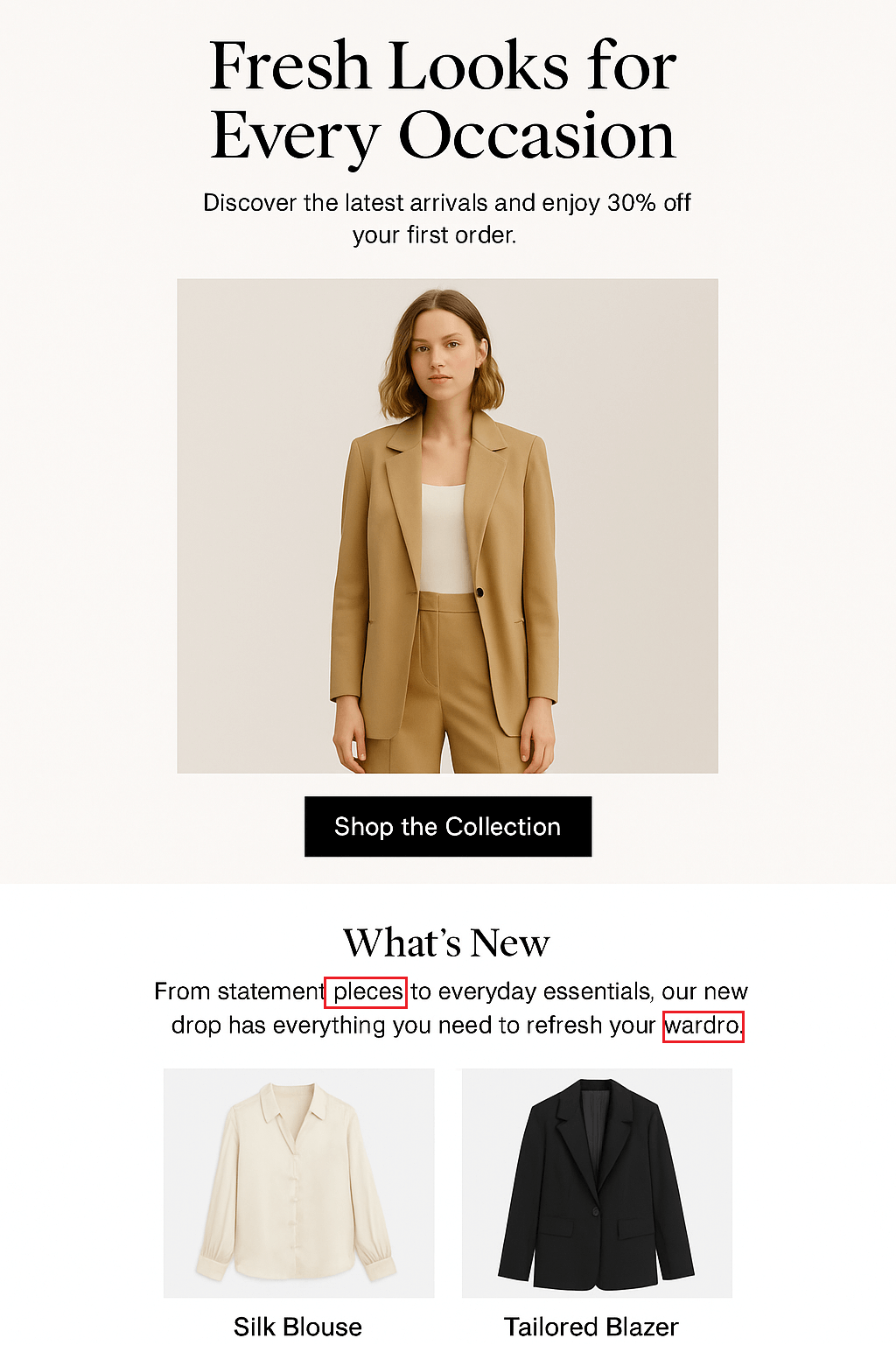
At first glance, it appears to be a polished promotional campaign from a fashion brand. But a closer look reveals obvious flaws.
- Misspelled text like “pleces” instead of “pieces” and the cutoff “wardro” instead of “wardrobe.”
- Odd spacing and kerning make the typography feel inconsistent.
- Product visuals that look more like generic mock-ups than real eCommerce photography.
- A hero image that feels slightly “off,” with stiff body posture and unnatural details in the clothing.
These errors may seem minor, but collectively, they give the email an unprofessional and rushed appearance. Instead of building trust, they undermine the brand’s credibility, making subscribers less likely to click or convert.
Plus, correcting these errors requires extra time, which defeats the purpose of using AI to create emails more quickly in the first place.
How to mitigate the risk
Utilize AI to streamline layout and formatting tasks, but exercise caution when selecting visuals.
Treat AI images as drafts or inspiration, invest human attention in refining design, and keep the message front and center. A clean email will always convert better than one that looks like it came straight out of an AI lab.
And remember, you don’t always need to start from scratch or rely on external AI design tools. Most ESPs already offer professional, mobile-ready templates that you can adapt in minutes.
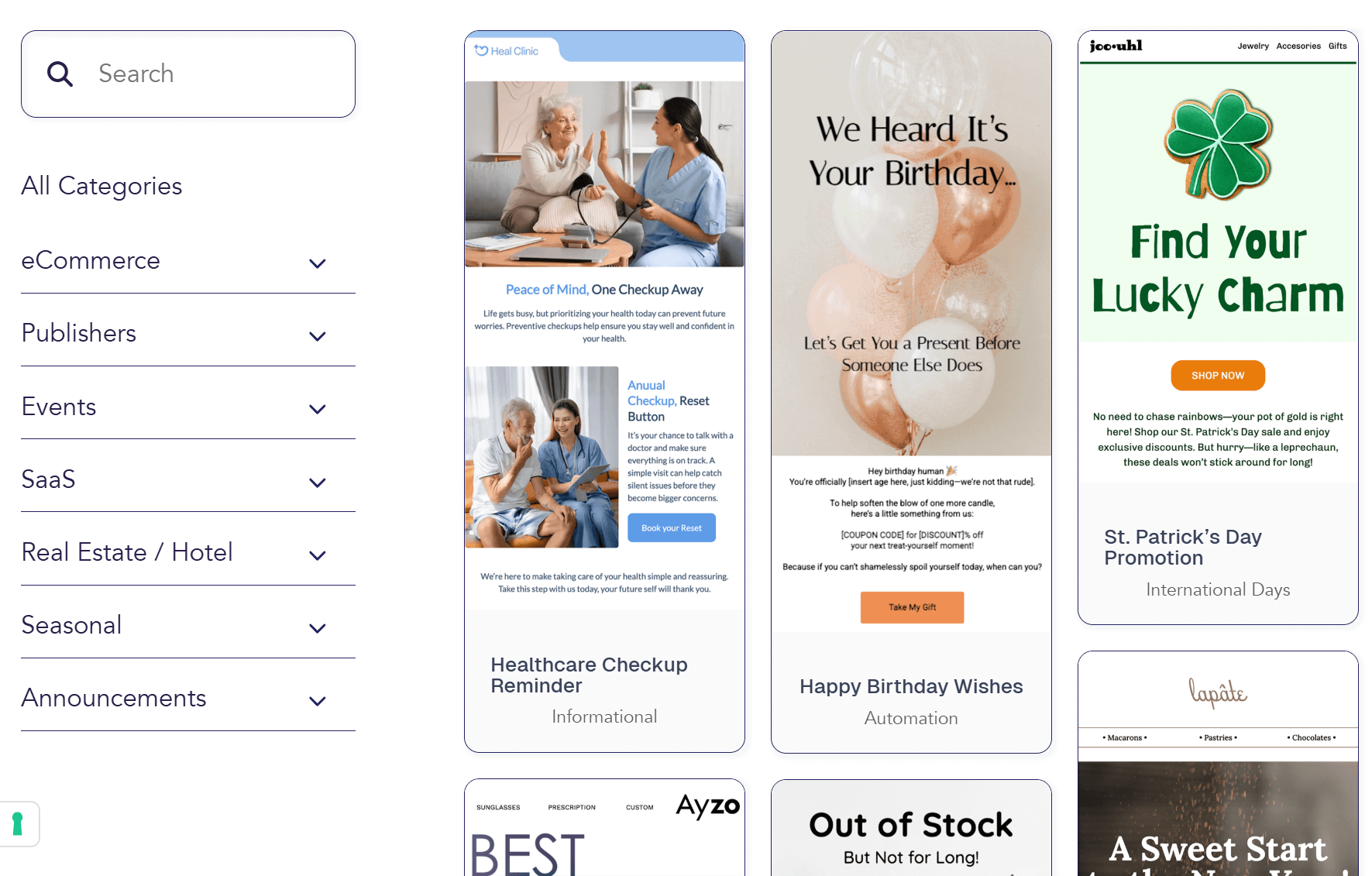
Many are also rolling out their own AI features to help streamline testing, personalization, and layout adjustments. Leveraging these built-in tools can speed up production while maintaining consistent design quality.
Email Security: Ensuring Message Compliance
AI is starting to play a role in compliance by scanning campaigns before they’re sent. It can flag missing unsubscribe links, detect subject lines that may be misleading, or verify that opt-in data meets the requirements of the GDPR and CAN-SPAM.
Some platforms even use AI to automate consent management, helping teams keep cleaner subscriber records.
The opportunity to improve compliance
Instead of manually checking every campaign against a long list of rules, AI can act as a first line of defense.
For example, if you forget to include an unsubscribe link in a promotional campaign, AI can detect the error before the email is sent, thereby reducing the risk of fines or spam complaints.
The risk of regulatory scrutiny
The danger comes when teams assume AI is foolproof. Overreliance creates a false sense of security, leading marketers to skip their own checks. And AI doesn’t always catch the nuances of compliance.
For instance, imagine a retailer preparing a Mother’s Day email campaign. The AI tool confirms that the design and subject line are compliant, but it overlooks the fact that the list includes contacts who have never given explicit consent under GDPR. The email goes out, complaints pile up, and the company faces regulatory scrutiny. The AI flagged technical issues but failed to assess the bigger compliance picture.
How to mitigate the risk
Use AI to handle routine checks, but keep human oversight for opt-in processes, consent records, and regulatory interpretation.
A combined approach will let you stay efficient without exposing your brand to unnecessary risk.
Email in the World of AI: Success Lies in How You Use It
It’s clear now that AI isn’t optional in email marketing. It’s already reshaping how campaigns are created, tested, and delivered. But whether AI becomes your greatest advantage or your biggest liability depends entirely on how you use it.
The real winners won’t be the brands that automate more, but those that strike a balance between efficiency and creativity, speed and strategy, and automation and human connection.
FAQs
Here’s some additional information regarding email marketing and AI.
1. What is AI hyper-segmentation in email marketing?
Hyper-segmentation goes beyond basic segmentation by dividing your list into very small groups based on behavior, preferences, or predicted actions. AI makes this possible, but it can also overwhelm subscribers if overused.
2. Can AI-generated content hurt email deliverability?
If AI content feels generic or misleading, subscribers may ignore it, unsubscribe, or mark it as spam. These actions lower the sender’s reputation, which affects deliverability across all campaigns.
3. How do ESPs use AI to support email marketing?
Many ESPs now include AI tools that generate subject lines, improve copy, optimize send times, and even automatically adapt templates. This helps teams streamline repetitive tasks while maintaining efficient campaigns.
4. Will AI replace human creativity in email marketing?
AI is best for handling drafts, testing, and analysis. Human creativity and oversight are still necessary to ensure campaigns are authentic and aligned with the brand’s voice.

